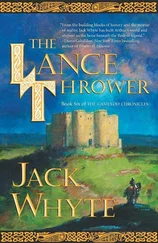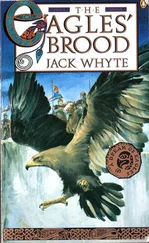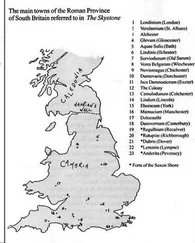
The Singing Sword
A Dream of Eagles 02
Jack Whyte
For Beverley ... my personal Jean Armour
AUTHOR'S NOTE
The Singing Sword is a work of fiction, but the historical background against which the action of the story takes place is very real, and the major political events occurred as described herein. As we approach the turn of a new century, few of us understand much of what went on at the birth of the twentieth. The story of The Singing Sword is set at the turn of the fifth century — fifteen hundred years ago — and most people have no idea at all what life could have been like in those days.
Some circumstances, occurrences, words and expressions in the narrative will be unfamiliar to modern readers. As the author, I could have changed or "modernized" all of these, but I have opted often to retain them in the interest of authenticity. Measurements, for example, were not as precise then as ours are now: seconds and minutes, inches and yards, were unknown to the Romans. They spoke in terms of heartbeats and moments, handspans and paces. A Roman mile was a thousand (mille) paces long, slightly less than a modern kilometre.
None of this should have any effect on the enjoyment of the story by modern readers, nor should this Author's Note be thought of as necessary reading before starting the tale itself. The purpose of the following information is merely to clarify some points that might be puzzling. Read on, by all means, but if you would rather plunge immediately into the story of The Singing Sword, please do. You may choose to refer back to this section as and if necessary.
Ranks and Titles
In the introduction to The Skystone, the first book of the four-volume cycle A Dream of Eagles, I included some notes on the composition of the Roman army, the legions of ancient Rome. I have not reproduced them all here, because by the time the events in this book took place the influence of the legions had declined, and they play no significant role in the story that follows. A few terms remain, however, from that root, and they are easily explained.
The cohort was a legion's major operating formation, as today's Company is a regiment's, and the senior Warrant Officer of each cohort was known as the pilus prior —- the front spear. The title of Lead Spear — primus pilus — was held by the senior Warrant Officer of the entire legion, the regiment to which the cohort belonged. The Commanding Officer of a legion was a Legate, and I have used that term interchangeably with the title "General," since that is what it means. Occasionally, a triumphant and popular general would be hailed in the field as "Imperator" by his victorious troops. Imperator literally means "Emperor," and by the end of the fourth century A.D., when Rome's day was almost over, many an emperor — most of them short-lived — was proclaimed in this manner.
The modern titles "Count" and "Duke" descend directly from the Roman titles and leadership roles of comes and dux, both popular in the late days of the Empire, but the best-known Roman rank today, thanks to Hollywood epics, is probably that of Tribune. Each legion had six tribunes, and they were the equivalent of today's Staff Officers: Colonels and Majors. The Roman court martial, with its jury of assembled tribunes, has given us the word tribunal.
Roman Cavalry
By the end of the second century AD,cavalry was playing an important role in Roman legionary tactics and represented up to one-fifth of overall forces in many military actions. Nevertheless, until the turn of the fifth century, the cavalry was the army's weakest link.
The Romans themselves were never great horsemen, and Roman cavalry was seldom truly Roman. They preferred to leave the cavalry to their allies and subject nations, so that history tells us of the magnificent German mixed cavalry that Julius Caesar admired, and which gave rise to the cohortes equitates, the mixed cohorts of infantry and cavalry used in the first, second and third centuries AD.Roman writers also mention with admiration the wonderful light horsemen of North Africa, who rode without bridles.
Fundamentally, with very few exceptions, cavalry were used as light skirmishing troops, mainly mounted archers whose job was patrol, reconnaissance and the provision of a mobile defensive screen while the legion was massing in battle array.
Roman cavalry of the early and middle Empire was organized in alae, units of 500 to 1,000 men divided into squadrons, or turmae, of 30 or 40 horsemen under the command of decurions. We know that the Romans used a kind of saddle, with four saddle horns for anchoring baggage, but they had no knowledge of stirrups, although they did use spurs. They also used horseshoes and snaffle bits, and some of their horses wore armoured cataphractus blankets of bronze scales, although there is little evidence that this form of armour, or armoured cavalry, was ever widely used.
Until the fifth century, and the aftermath of the Battle of Adrianople, it would seem that almost no attempt had been made to study the heavy cavalry techniques used in the second century BCby Philip of Macedon and his son Alexander the Great. It was that renaissance, allied with the arrival of stirrups in Europe somewhere in the first half of the fifth century, that changed warfare forever. In terms of military impact, the significance of the addition of stirrups to the saddle was probably greater than that of the invention of the tank.
The Early Christians and Their Christ

We use the name Jesus Christ today as though the two words were first name and surname, but that is a relatively modern usage. To the Christians of the Roman Empire in the fourth and fifth centuries, Jesus was "Jesus, Christus" — Jesus the Christ — because Christus means the Savour, the Redeemer. The definite article is built into the name. For that reason, the device shown on the left, known to us as the Chi-Rho monogram, was in widespread use at that time as the Christians' symbol of belonging.
The Greek letters Chi and Rho, joined in the monogram exactly as they are today in Christian liturgical vestments, were the first two letters of the written word Christus, and the Chi-Rho had long since replaced the sign of the fish, which had been the password of the earliest, persecuted Christians.
Proper arid Place Names
Most of the names used for characters in this novel would have been common in Roman times. The following is a guide to phonetic pronunciation:
Caesarius
[Cee-zary-us
Caius
[Kay-us^
Claudius
[Klawdy-us
Flavius
[Flavey-us
Gaius
[Guy-us
Luceiia
[Loo-chee-ya
Plautus
[Plough-tus
Quintus
[Kwin-tus
Seneca
[Sen-nic-a
Stilicho
[Stil-itch-o
Tertius
[Tershy-us
Theodosius
[Theo-dozy-us
Valentinian
[Valen-tinny-an
Vegetius
[Ve-jeeshy-us
The land the Romans called Britain was only the land we know today as England. Scotland, Ireland and Wales were separate and known respectively as Caledonia, Hibernia and Cambria. They were not recognized as part of the province of Britain.
The ancient towns of Roman Britain are still there, but they all have English names now. What follows is a guide to phonetic pronunciation of Roman place names, with their modern equivalents. They are numbered to correspond to the map provided.
Читать дальше











